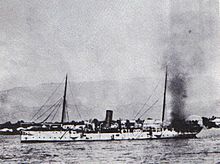
The seventh USS Washington (ACR-11/CA-11/IX-39), also referred to as "Armored Cruiser No. 11", and renamed Seattle and reclassified CA-11 and IX-39, was a United States Navy Tennessee-class armored cruiser. Commissioned in 1906, renamed in 1916, and not decommissioned until 1946, she spent periods of time in reserve. She was used for escort duties during World War I, and as a receiving ship during World War II.

Cap-Haïtien, typically spelled Cape Haitien in English, is a commune of about 274,000 people on the north coast of Haiti and capital of the department of Nord. Previously named Cap‑Français and Cap‑Henri during the rule of Henri I, it was historically nicknamed the Paris of the Antilles, because of its wealth and sophistication, expressed through its architecture and artistic life. It was an important city during the colonial period, serving as the capital of the French Colony of Saint-Domingue from the city's formal foundation in 1711 until 1770 when the capital was moved to Port-au-Prince. After the Haitian Revolution, it became the capital of the Kingdom of Haiti under King Henri I until 1820.
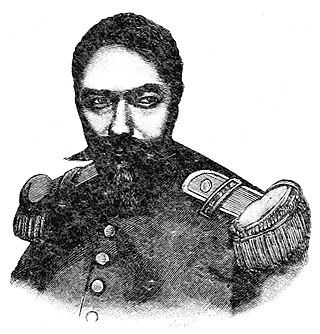
Sylvain Salnave was a Haitian general who served as the President of Haïti from 1867 to 1869. He was elected president after he led the overthrow of President Fabre Geffrard. During his term there were constant civil wars between the various factions. Eventually, he was overthrown in a coup by his eventual successor Nissage Saget, and Salnave was tried for treason and executed.

Gunboat diplomacy is the pursuit of foreign policy objectives with the aid of conspicuous displays of naval power, implying or constituting a direct threat of warfare should terms not be agreeable to the superior force.

SMS Panther was one of six Iltis-class gunboats of the Kaiserliche Marine that, like its sister ships, served in Germany's overseas colonies. The ship was launched on 1 April 1901 in the Kaiserliche Werft, Danzig. It had a crew of 9 officers and 121 men.

Charles Moravia was a Haitian poet, dramatist, teacher, and diplomat.

SMS Vineta was a protected cruiser of the Victoria Louise class, built for the German Imperial Navy in the 1890s. Vineta was laid down at the AG Vulcan shipyard in 1895, launched in April 1897, and commissioned into the Navy in July 1898. The ship, named for the earlier screw frigate SMS Vineta, was armed with a battery of two 21 cm guns and eight 15 cm guns and had a top speed of 19 knots. Though the five Victoria Louise-class cruisers proved to be disappointing in some ways, they marked the beginning of a decade of German cruiser construction.

USS De Soto was a fast wooden-hulled sidewheel steamship that saw service as a U.S. Navy gunboat during the American Civil War.

USS Galatea was a large steamer acquired by the Union Navy during the American Civil War.

USS Galena was a wooden armed steamer in commission in the United States Navy from 1880 to 1890. She had an active career in which she operated in the North Atlantic Squadron and South Atlantic Squadron, seeing duty in the Mediterranean Sea and Aegean Sea, along the east coast of South America, in the Caribbean, in the waters of Canada, and along the United States East Coast and United States Gulf Coast.

The Saint-Domingue expedition was a large French military invasion sent by Napoleon Bonaparte, then First Consul, under his brother-in-law Charles Victor Emmanuel Leclerc in an attempt to regain French control of the Caribbean colony of Saint-Domingue on the island of Hispaniola, and curtail the measures of independence and abolition of slaves taken by the former slave Toussaint Louverture. It departed in December 1801 and, after initial success, ended in a French defeat at the Battle of Vertières and the departure of French troops in December 1803. The defeat forever ended Napoleon's dreams of a French empire in the West.
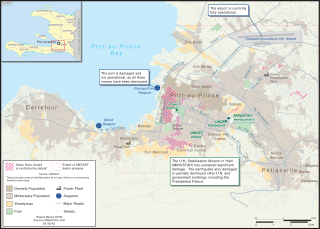
Killick is the Haitian Coast Guard base in Port-au-Prince. It is the main base for the Coast Guard. It is the other port for the city, aside from the main Port international de Port-au-Prince. It is located about 10 miles outside of downtown Port-au-Prince, and is about a century old. The base is named after Admiral Hammerton Killick of the Haitian Navy, who scuttled his own ship, the Crête-à-Pierrot, a 940-ton screw gunship, by igniting the magazine, and went down with the ship, instead of surrendering to German forces, in 1902, at Gonaïves, Haiti.

The Haitian Coast Guard, officially the Haitian Coast Guard Commission, is an operational unit of the Haitian National Police. It is one of the few law enforcement organisations in the world to combine water policing and coast guard duties while remaining as a policing unit. It operates primarily as a law enforcement agency, with secondary responsibilities in search and rescue.

The Armed Forces of Haiti are the military forces of the Republic of Haiti, is composed of the Haitian Army, the Haitian Navy, and the Haitian Aviation Corps. The Force has about 2000 active personnel as of 2023, with the army and aviation corps being active, and navy personnel still in the works.

The Venezuelan crisis of 1902–1903 was a naval blockade imposed against Venezuela by Great Britain, Germany, and Italy from December 1902 to February 1903, after President Cipriano Castro refused to pay foreign debts and damages suffered by European citizens in recent Venezuelan civil wars. Castro assumed that the American Monroe Doctrine would see Washington intervene to prevent European military intervention. However, at the time, United States president Theodore Roosevelt and his State Department saw the doctrine as applying only to European seizure of territory, rather than intervention per se. With prior promises that no such seizure would occur, the U.S. was officially neutral and allowed the action to go ahead without objection. The blockade saw Venezuela's small navy quickly disabled, but Castro refused to give in, and instead agreed in principle to submit some of the claims to international arbitration, which he had previously rejected. Germany initially objected to this, arguing that some claims should be accepted by Venezuela without arbitration.
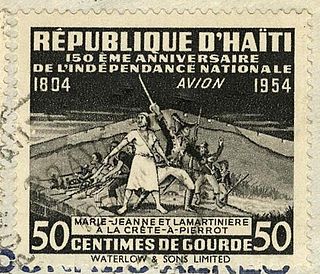
Marie-Jeanne Lamartinière was a Haitian revolutionary, soldier, and nurse. Described as a Mulatto, she was raised on a plantation in Port-au-Prince. Marie-Jeanne received formal education before marrying Louis Daure Lamartinière, an officer of the Armée Indigène. In 1802, she fought alongside him and his army against French forces in the Battle of Crête-à-Pierrot. Her attire and weaponry were noted, and she was described as courageous. After a bombardment by the French, Marie-Jeanne retreated with Louis and his army, and after his death, she had relationships with two other army officers. Though little is known about Lamartinière, she is popular across Haiti and was printed on a postage stamp and coin.
Heinrich Paul Christian Richard Eckermann was an officer of the German Imperial Navy, rising to Vizeadmiral in the First World War.
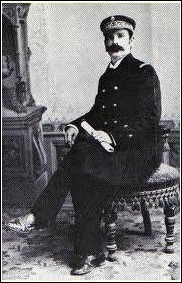
Hammerton Killick was an admiral in the Haitian Navy. He was killed in the 1902 Firmin rebellion when he refused to surrender his ship to the German warship SMS Panther. A naval base in Port-au-Prince is named after him. A 1943 Haitian postage stamp commemorated his role in the rebellion.

Crête-à-Pierrot was a gunboat in the Haitian Navy named after the 1802 Battle of Crête-à-Pierrot in the Haitian Revolution. The boat was destroyed by Admiral Hammerton Killick in 1902 to prevent it falling into the hands of a German warship.

German–Haitian relations date back to the time before the country's independence. They were characterized by trade in the 19th century. In the 20th century, they lost importance due to political developments in both Germany and Haiti.
